“We [EU Member States] reiterate that terrorism, radicalisation, recruitment and financing related to terrorism are main common threats to the internal security of the EU”.
The 2015 Riga Joint Statement1
The vigilance of law-enforcement and security agencies, international cooperation on counter-terrorism mechanisms, and extensive collaboration between public and private stakeholders in the security scenario, has enabled the effectiveness in countering the plots of terrorist attacks. However, amid Coronavirus pandemic, Europe is facing an escalating and severe threat with the expansion of Islamist terrorism. The Islamic State-inspired terrorist attacks in France and Austria have highlighted that the group may have lost the physical territories in Iraq and Syria, but after a minuscule lapse of time, it has placed a firm footprint with the expansion of Islamic terrorism in Europe.
In 2018 and 2019’s Global Terrorism Index reports, France slipped six ranks (from 30 to 36) and Austria five ranks (from 79 to 84) respectively. The downward slide indicates that in comparison to terrorist attacks in 2018, both countries (France and Austria) witnessed a lesser number of terrorist attacks in 2019.2 In the past, European nations such as France and Spain used to face terror threats from nationalist/separatist movements; however, the momentum of attacks has shifted from separatist to religiously-inspired attacks with the surge in terrorist attacks carried out by the operatives of Islamist terrorist organisations such as Islamic State (IS) and al-Qaeda (AQ).
In the early 2000s, the term “Islamist terrorism” or “jihadist terrorism” emerged with the frequent coordinated terrorist attacks, mainly bombings, in Europe which are mostly linked with al-Qaeda. The 2004 Madrid train bombings and 2005 July London bombings are still counted as the deadliest bombings in two of the member states of the European Union (EU). However, with the emergence of Islamic State (IS) or Islamic State in Iraq and Levant (ISIL) or Daesh (Arabic acronym of ISIL) in 2014, the European countries have witnessed a rise in terrorist attacks. During 2014-2016, a higher number of terrorist conspiracies had gone undetected and turned into deadly terrorist attacks in different parts of Europe. The November 2015 Paris attack, March 2016 Brussels bombings, and the July 2016 lone-wolf “truck” attack in Nice, are some of the notable terrorist incidents coordinated by the IS. In 2014-2016, the number of people killed in Islamist terrorist attacks (273 people) was higher than in all previous years combined (267 people).3
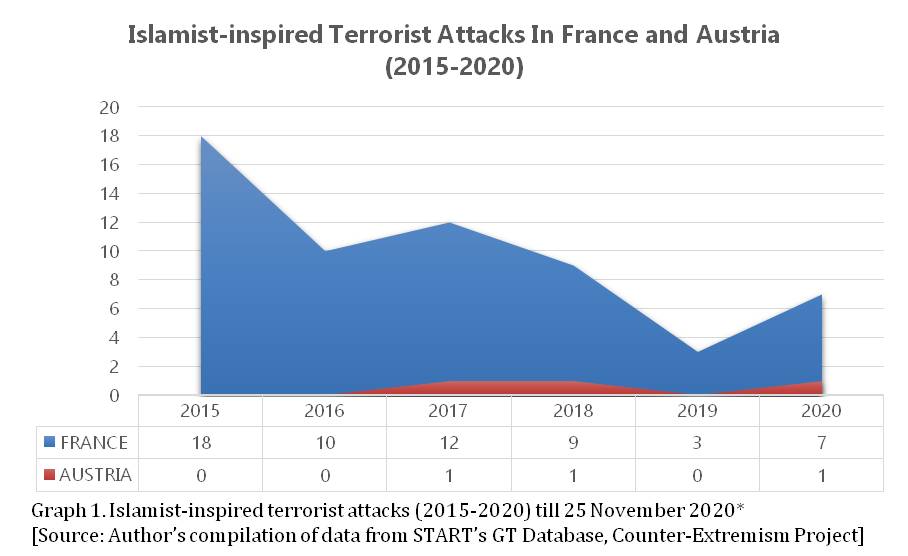
Lone-wolf attacks are one of the favoured tactics of IS. Opposite to the call made in mid-2014 to do hijra (emigration) to IS-controlled territories in Iraq or Syria, the IS sympathisers are given options either to join the affiliated sleeper cells or carry-out a lone-wolf attack in their respective countries; due to several restrictions and stringent checks regulated by the EU member nations.
Comparing to France, Austria has experienced less Islamist-inspired terrorist incidents in the last five years (2015-2020). The comparative data of terrorist incidents in France and Austria is depicted in Graph 1. There has been a surge in lone-wolf attacks carried out in European countries since 2014, mainly in the United Kingdom (2019 London Bridge attack and 2020 Streatham terror attack), and recently in France and Austria. Through this article, the author would like to present the cases of recent Islamic State (IS) inspired attacks in France and Austria, along with providing a comparative analysis of available data on terrorist incidents in last five years in both countries to the readers.
Lone-Wolf Attacks—A Significant Threat
France
On 07 January 2015, France had witnessed the first major Islamic-inspired terrorist attack when two al-Qaeda linked attackers—Cherif and Said Kouachi stormed the offices of the Charlie Hebdo—a French satirical magazine, in Rue Nicolas-Appert street in Paris and killed 12 people.4 Post-Charlie Hebdo terror attack, the European Union (EU) assessed the situation and ramped up measures to counter the emerging threat of Islamic terrorism among its Member States. On 29 and 30 January, EU’s Justice and Home Affairs Ministers gathered during an informal meeting at Riga, Latvia and they declared the “Riga Joint Statement”—highlighting the EU Member States (MS)’s concern on the growing threat from the IS Foreign Terrorist Fighters (FTFs) and reinforcement of the counter-terrorism efforts—
“The recent terrorist attacks in France, the counter-terrorism measures are taken in Belgium, and the growing threat posed by the phenomenon of foreign terrorist fighters all over the world sends a clear and strong message that counter-terrorism efforts have to be reinforced both at national and EU level.”5
The Riga Joint Statement also considered the need to amend the “Schengen Borders Code” with stringent checks on the free movements. Based on the expected risk indicators, the proposed border codes provided a systematic check on individuals enjoying the rights of the free movement against databases required to fight against terrorism.
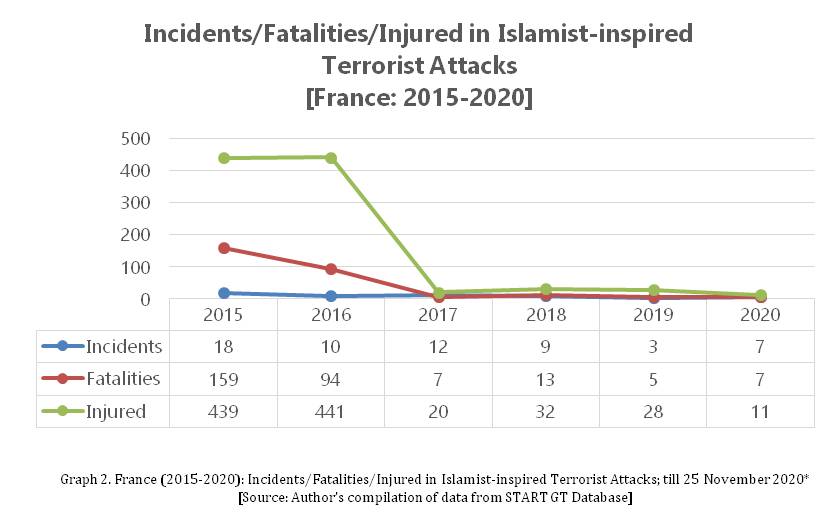
As shown in Graph 2, during 2015-2020, France had witnessed 59 terrorist attacks in which 285 people lost their lives, and more than 900 were injured. Around 40 out of the total 59 attacks took place from 2015 to 2017—peak years of the Islamic State. The year 2020 (till 23 November) recorded an increase of 133.3 per cent (07 attacks) in comparison to the number of attacks took place in 2019 (03 attacks). The significant rise in the attacks shows the growing threat of lone-wolf attacks under the shadows looming over France and the other EU Member States.
In a research paper “The Foreign Fighters Phenomenon in the European Union” published in 2016, the International Centre for Counter-Terrorism (ICCT)—The Hague6 has highlighted figures of foreign terrorist fighters (FTFs) from France, travelling to IS-controlled territories in Iraq and Syria to fight alongside Islamic State. France has been the largest source of FTFs with an estimated 2,000 French citizens moved to conflict areas by the end of May 2016. According to the report, around 75 per cent of migrated French nationals had joined the Islamic State, and 25 per cent had joined Jabhat al-Nusra.7

From January 2015 to October 2016, the French government had launched a campaign— “Stop Djihadisme” [Stop Jihadism], which involved online resources available to French nationals to identify and report terrorist suspects, and further how to respond during a terrorist attack. After nine months, the government ended the programme due to concerns of a high probability of radicalisation rather than containing its spread among Islamic extremists.8
In the year 2020, France has witnessed six major Islamic-inspired terrorist attacks, out of which in five attacks, a knife was the primary weapon. The brutal killing of Samuel Paty (16 October 2020) was the second lone-wolf terrorist attack in connection with the 2012 Charlie Hebdo’s caricature of prophet Mohammad, which led to the deadliest Islamic terrorist attacks in Paris in 2015. Earlier, in September, Zaher Hassan Mahmood (25 years-old) Pakistani immigrant stabbed two people to injuries outside the former offices of Charlie Hebdo after watching videos of protests in Pakistan over the republications of the caricatures.9 The following sections shall be discussing the two knife attacks that took place recently in Paris and Nice in October and November 2020, respectively.
Beheading of Samuel Paty
Keeping the religious sentiments of Muslim students in mind, civics teacher at the College Bois-d’Aulne in Conflans-Sainte-Honorine, France—Samuel Paty (47 years-old) had displayed two cartoons of prophet Mohammed from Charlie Hebdo magazine as the part of the lesson “Freedom of Expression” on 05 October. However, before displaying the cartoons, Paty had requested Muslim students to leave the classroom if they prefer to.10 Some Muslim parents objected the actions of Paty as an act of “blasphemy” and asked the college to suspend him as a tutor. A week before the murder of Paty, the Grand Mosque de Pantin’s Imam (religious leader)—Abdelhakim Sefrioui encouraged other parents to join the protest against Paty, describing him as a thug.11
On the evening of 16 October, a week and half-later of displaying the cartoons, Samuel Paty was decapitated by the Islamic extremist and Russian immigrant of Chechen ethnicity—Abdoullakh Abouyedovich Anzorov (18 years-old) to avenge the lampooning of prophet Mohammad during a lesson on “Freedom of Expression” earlier of the same month.12
The Perpetrator—Aboullakh Abouyedovich Anzorov
Samuel Paty’s murderer—Abdoullakh Anzorov was an 18 years-old Russian immigrant of Chechen ethnicity. Anzorov and his family migrated to France on a refugee status after Anzorov’s half-sister had joined IS in 2014.13 In March 2020, Anzorov and his family, including father and mother, received 10-year Residency status. On 16 October (afternoon), Anzorov visited the school and asked people to point-out Samuel Paty. After identifying Paty, Anzorov followed him and later inflicted several wounds on his head with a knife and then beheaded Paty while shouting “Allah-u-Akbar”.14 After decapitating Samuel, Anzorov posted the photograph of Samuel’s decapitated head with caption—“I have executed one of the dogs from hell who dared to put Mohammad down”, on his Twitter account—@tchetchene_270. Soon, French police chased him and asked to surrender; but Anzorov—armed with a knife and air-soft gun threatened police. In response, police engaged and killed Anzorov.15
Surprisingly, Anzorov had no connection with its target—Samuel Paty or school; then what sparked the hatred in thoughts of Anzorov who brutally decapitated Paty pointed towards his radicalisation. The investigation revealed that before the attack, Anzorov was in contact with two jihadists (unidentified) from Syria. In an audio message recorded in Russian language and posted on his Instagram account instantly after the killing, Anzorov claimed that he has avenged the insult of Prophet Mohammad and requested others to pray that Allah accepts him as a martyr.16
2020 Nice Stabbing
France was still not over from mourning the brutal killing of Samuel Paty; and another Islamic-inspired terrorist attack took place in the city of Nice, France. At 0830 hrs (1300 hrs IST) on 29 October 2020, a Tunisian national—Brahim Aouissaoui (21 years-old) attacked and killed three people (two women and a man) at Notre-Dame de Nice—a Roman Catholic Basilica in Nice, France.17 In the heinous act which lasts for less than 30 minutes, the attacker was shouting “Allah-u-Akbar” while attempting to behead one of the victims—60 years-old woman inside the Church. Soon, the attacker approached the next two victims and stabbed them to death.
Swiftly, the police teams reached the incident site and first electro-shocked the attacker with a taser gun and then shot him, resulting in injuries. Despite the shot wounds, the attacker kept on shouting “Allah-u-Akbar”. Later, the injured attacker was taken to the hospital for treatment and further investigation process. Police officials recovered a copy of the Holy Koran, three knives, and two cellular phones from his possession.18
The Tunisian Attacker—Brahim Aouissaoui
Brahim Aouissaoui—a 21 years-old Tunisian national has been identified as the perpetrator in the Nice stabbing in which he killed three people. In late September 2020, without informing his family about travelling plans, Brahim arrived in Italy as a refugee during the coronavirus outbreak in Tunisia. However, on 09 October, the Italian authorities notified Brahim that he would be expelled from Italy on the grounds of illegal entry, but his movements would not be monitored.19
According to news sources, on 27 October, Brahim travelled to Nice via train; as he had an identity card facilitated by the Italian Red Cross Society, which made his transit convenient from Italy to France.20 Despite, the incident of 16 October (killing of Samuel Paty), he was allowed entry without raising any suspicions and was unknown to the French anti-terrorism authorities. After restraining him at the crime scene, with a taser gun and several shots, Brahim was taken to hospital where he was discovered positive with coronavirus during a medical examination.21 Brahim’s transit from Italy to France being a coronavirus carrier has raised questions about the preventive measures taken by the Italian and French authorities to identify travellers affected with the virus. The investigation carried out by the Tunisian authorities has revealed no evidence of Brahim’s radicalisation or any premeditated intentions to carry out a terrorist attack on the European soil.22
The investigation has revealed a connection with the incident of killing of Samuel Paty. The digital forensic examination of Brahim’s mobile phone has discovered the photographs linked with the beheading of Samuel Paty, including the images of Islamic State terror organisation, on it.23 The Islamic-inspired terrorism has been in existence in France for several years. The recent attacks are linked with the outrage spurred from the depiction of the caricatures of Prophet Mohammad published by the French magazine Charlie Hebdo. The French authorities have defended the right to publish such cartoons as the freedom of expression, whereas Muslims see these actions as an act of Blasphemy.
Austria
Although since 2015, Austria has witnessed minuscule terrorist attacks, (three incidents till November 2020), there have been numbers of terror plots and attacks foiled by the Austrian security agencies. According to the collective data from 2015-2019, around 202 people linked to Islamic terrorism, were arrested from different locations in Austria. In the last half-decade, Islamic terrorism-linked arrests made in Austria were 6.7 per cent of the total arrests made in Europe (3,057 arrests).24 In a case of May 2015, Merkan G (14 years-old)—a migrant Turkey-born boy was charged with conspiracy of building a bomb and establishing contacts with the Syria-based al-Qaeda (AQ) and IS terrorists. Merken was living in Austria since 2007. For terrorist offences Merken was given an eight-month jail sentence in Austria.25 In a research paper “The Foreign Fighters Phenomenon in the European Union” published in 2016, the International Centre for Counter-Terrorism (ICCT)—The Hague26 has highlighted figures of foreign terrorist fighters (FTFs) from Austria who have travelled to IS-controlled territories in Iraq and Syria to fight alongside Islamic State.

As shown in Table 1, during the peak time of Islamic State (2014-2017), around 300 men and women joined IS as the foreign terrorist fighters (FTFs) and according to the tentative data provided by the Austrian authorities, more than 70 had returned to the country. Likewise, most of the FTFs who joined different parts of the world, the age factor and the ethnic background have highlighted to what extent young Muslim generation from migrated families in Austria inclined towards radicalisation and ideology of Islamist extremism.
Vienna Attack 2020
At local time 2000 hrs (0030 hrs IST) on 02 November 2020, an Islamic State (IS) sympathiser identified as Kujtim Fejzullai carried out a “lone-wolf” attack in central Vienna before the Austrian police eliminated him. Equipped with a rifle, a handgun and a machete, Kujtim killed four people (two men and two women) and injured at least 14 others, including a police official.27 The attack took place when people were enjoying the night at Vienna’s cafes and restaurants before the lockdown on the following day due to coronavirus pandemic. According to police, unverified visuals floating on social media had indicated six shooting locations across Vienna. However, on the following day, authorities confirmed that it was a lone-wolf attack with no other shooters involved in the attack.28 Initially, the attack began at the busy shopping district near Vienna’s main synagogue—Seitensttengasse Temple29; therefore, anti-Semitism as a motive behind the attack cannot be ruled out.
Police authorities had urged the general public to refrain themselves from posting shooting videos/visuals on social media and instead submit it to the police. In response to the urge, police had received more than 20,000 videos from the public.30 There are no credible shreds of evidence on if any IS-module or sleeper cell has conspired the attack; however, IS has always claimed the responsibilities of the lone-wolf attacks earlier too.
Kujtim Fejzullai— 20 years-old Perpetrator
On the following day of the attack, i.e. on 03 November, Islamic State (IS) claimed the responsibility of attack by posting a photograph of the perpetrator—Kujtim Fejzullai (20 years-old) aka Abu Dujana al-Albani, with guns and a knife and also released the video of the perpetrator pledging allegiance to the current leader of IS—Abu Ibrahim al-Hashimi al-Qurashi.31
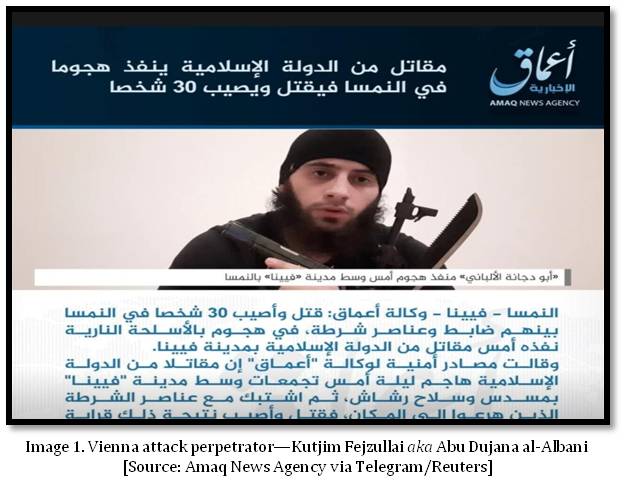
On 03 November, Islamic State released its newsletter—“al-Naba” issue 259 in which it claimed the responsibility of the attack by releasing the video snapshot of the attacker while attacking the streets of the Vienna. The headline of the report read as— “Armed with his faith and his rifle: an Islamic State soldier kills and injures nearly 30 in the crusader attack in the heart of the Austrian capital (Vienna)”.32
It was April 2019 when Kutjim appeared onto the radar of Austrian law-enforcement while attempting to join and travel to IS-controlled territory in Syria. Upon his arrest, Kutjim was sentenced for 22 months of jail term; but later was released on Parole in December 2019 and enrolled for one of the government’s de-radicalisation programmes. “The perpetrator [Kutjim] managed to fool the justice system’s de-radicalisation programme, further fooling people in it, and to acquire an early release through deceiving the probation officers”, said Austria’s Interior Minister Karl Nehammer.33
Earlier in January 2017, the Austrian authorities had arrested 14 Islamic State suspects in a series of counter-terrorism raids in Vienna and Gaz. Ironically, in February 2019, all 14 IS suspects were released from “pre-trial” detention as the prosecution failed to press charges due to complexity of evidence submitted in the case.34 The Interior Minister Nehammer’s statement somewhere signals the “loophole” in the justice system and failure to predict if a convicted person is still vulnerable to radicalisation and pose a severe threat to the society if released.
Wake-Up Call for the Europe
Unlike de-radicalisation programmes in prison, the French government had opened 12 de-radicalisation centres—“Centre for the Prevention, Integration and Citizenship” in a smaller town of Beaumont-en-Veron, south of Paris in September 2016.35 The objectives of these de-radicalisation centres were to work on the rehabilitation of the individuals who signalled the early signs of radicalisation. However, according to French intelligence and counter-terrorism experts, the de-radicalisation centre concept was a fiasco. In an interview, French intelligence expert and Director of the Centre for the Analysis of Terrorism—Jean-Charles Brisard emphasised that it is [imaginative] to de-radicalise individuals. Rather than changing the minds of people, the best approach would be the involvement of all stakeholders at all levels.36
The Islamic State-inspired lone-wolf attacks in France and Austria have highlighted the very much existence and shadowy expansion of dangerous ideology of Islamic terrorism in Europe. A study of the profiles of the lone-wolf attackers or perpetrators highlights the “loophole” in the Justice System and government-sponsored de-radicalisation programmes. Similar to the profiling of other IS-inspired lone-wolf attackers—Usman Khan (2019 London Bridge attack) and Sudesh Amman (2020 Streatham terror attack), Kutjim—Vienna attacker managed to fool the officials of Austria’s DERAD association and was able to carry out the attack.
The young generation of Muslims in France who belong to the third or fourth generation of a migrant family, have been feeling a sense of alienation which further pushed them towards extremism. In a colloquial manner in the United States (US), the identity of a migrant is hyphenated with “American”, such as American-India, American-Pakistani, Latin-American; but in France, either it would be a “French” or nothing. In a diverse French society where one in 10 people are immigrants37, being French is meant with acting French in the terms of nationalism. Equipped with skills and academic degrees, young Muslim population faces hardships in employment opportunities due to several socio-economic factors prevailing in France. Every Islamic-inspired terrorist attack in France sparks a wave of doubts on the loyalty of the Muslim population towards its republic and values. In turn, the unemployability and a sense of alienation from the mainstream works as a critical factor in the radicalisation of the youth and spurs further recruitment into transnational terrorist organisations.
Muslims must understand that any act of terrorism or any form of extremism is not the accurate interpretation of their Holy scripture and does not justify the killing of innocent people, mainly women, children, and older, in the name of religion. The cultural and national values of a nation shall be respected as the rightful duty of being a citizen of that respective country. On the other side, the respective governments should also respect the religious and cultural values of the Muslim population living as responsible citizens. Along with other efforts to minimise the threat of Islamist terrorism, it is essential to work upon the concepts and implementation of anti-radicalisation or counter-radicalisation programmes because “Prevention is always better than the Cure”.
Endnotes
- “Riga Joint Statement”, 2015, Available from:
https://eu2015.lv/images/Kalendars/IeM/2015_01_29_jointstatement_JHA.pdf - “Global Terrorism Index 2018”, Institute for Economics & Peace, 2018, Available from: https://reliefweb.int/sites/reliefweb.int/files/resources/Global-Terrorism-Index-2018-1.pdf ; “Global Terrorism Index 2019”, Institute for Economic & Peace, 2019, Available from: https://reliefweb.int/sites/reliefweb.int/files/resources/GTI-2019web.pdf
- Nesser, Petter, Anne Stenersen, and Emilie Oftedal. “jihadi terrorism in Europe: the IS-effect”, Perspective on Terrorism Vol 10 Issue 6, 2016, Available from:
http://www.terrorismanalysts.com/pt/index.php/pot/article/download/553/1096 - “Charlie Hebdo attack: Three days of terror”, BBC News, 14 January 2015, Available from: https://www.bbc.com/news/world-europe-30708237
- “Riga Joint Statement”, 2015, Available from:
https://eu2015.lv/images/Kalendars/IeM/2015_01_29_jointstatement_JHA.pdf; “Motion for Resolution”, European Parliament, 04 March 2015, Available from:
http://www.europarl.europa.eu/doceo/document/B-8-2015-0221_EN.doc - Boutin, Berenice, Gregory Chauzal, Jessica Dorsey and et al. “The Foreign Fighters Phenomenon in the European Union: Profiles, Threats and Policies”, The International Centre for Counter-Terrorism—The Hague, April 2016, Available from: https://icct.nl/app/uploads/2016/03/ICCT-Report_Foreign-Fighters-Phenomenon-in-the-EU_1-April-2016_including-AnnexesLinks.pdf
- Ibid.
- Bisserbe, Noemie. “French prisons to stop segregating Islamist inmates”, The Wall Street Journal, 25 October 2016, Available from: https://www.wsj.com/articles/french-prisons-to-stop-segregating-islamist-inmates-1477419245
- Onishi, Norimitsu and Constant Meheut. “Suspect stalked French school before beheading teacher, official say”, The New York Times, 17 October 2020, Available from: https://www.nytimes.com/2020/10/17/world/europe/france-beheading-teacher-paris-suburb.html
- Willsher, Kim. “Teacher decapitated in Paris named as Samuel Paty, 47”, The Guardian, 17 October 2020, Available from: https://www.theguardian.com/world/2020/oct/17/teacher-decapitated-in-paris-named-as-samuel-paty-47
- Ibid.
- Paone, Antony. “For a teacher in France, a civics class was followed by a gruesome death”, Reuters, 17 October 2020, Available from: https://www.reuters.com/article/france-security-school-parents-idINKBN27201Z
- Oppenheim, Maya. “Paris terror attack: France mourns decapitated teacher at rallies”, The Independent, 18 October 2020, Available from: https://www.independent.co.uk/news/world/europe/paris-terror-attack-france-samuel-paty-teacher-death-rallies-b1129855.html
- “France teacher attack: suspect ‘asked pupils to point Samuel Paty out”, BBC News, 17 October 2020, Available from: https://www.bbc.com/news/world-europe-54581827
- Oppenheim, Maya. “Paris terror attack: France mourns decapitated teacher at rallies”, The Independent, 18 October 2020, Available from: https://www.independent.co.uk/news/world/europe/paris-terror-attack-france-samuel-paty-teacher-death-rallies-b1129855.html ;
Connelly, Eileen. “Attacker asked kids to point out teacher he then beheaded: French cops”, New York Post, 17 October 2020, Available from: https://nypost.com/2020/10/17/french-cops-grill-9-after-teacher-beheaded-in-terror-attack/ - “France teacher’s killer had ‘contact’ with jihadists in Syria”, France 24, 22 October 2020, Available from: https://www.france24.com/en/live-news/20201022-france-teacher-s-killer-had-contact-with-jihadist-in-syria
- Salaun, Tangi and Eric Gaillard. “Tunisian man beheads woman, kills two more people in Nice church”, Reuters, 29 October 2020, Available from: https://www.reuters.com/article/us-france-security-nice/two-dead-in-knife-attack-in-french-church-official-say-terrorism-suspected-idUSKBN27E17D
- Smith, Saphora, Ing Nancy and Tim Stelloh. “French authorities say suspect in Nice church attack is a Tunisian national”, NBC News, 29 October 2020, Available from: https://www.nbcnews.com/news/world/two-dead-others-injured-suspected-terrorist-attack-french-church-n1245222
- Burke, Jason and Lorenzo Tondo. “Suspect in Nice terror attack phoned his family hours before rampage”, The Guardian, 30 October 2020, Available from: https://www.theguardian.com/world/2020/oct/30/nice-terror-suspect-phoned-family-hours-before-church-attack-brahim-aouissaoui
- Sonawane, Vishakha. “Who is Brahim Aouissaoui? Tunisian-Born Nice Church Attacker Arrived In France Just Weeks Before Attack”, International Business Times, 30 October 2020, Available from: https://www.ibtimes.sg/who-brahim-aouissaoui-tunisian-born-nice-church-attacker-arrived-france-just-weeks-before-attack-52939
- AFP. “French church attacker tests positive for coronavirus”, The Times of India, 03 November 2020, Available from: https://timesofindia.indiatimes.com/world/europe/french-church-attacker-tests-positive-for-coronavirus/articleshow/79018645.cms
- Benlakehal, Massinissa. “Digging up the past of the Nice attacker, who killed three French citizens”, TRT World, 06 November 2020, Available from: https://www.trtworld.com/magazine/digging-up-the-past-of-the-nice-attacker-who-killed-three-french-citizens-41229
- Reuters. “French prosecutors: Nice church attack and teacher’s beheading are linked”, FirstPost, 14 November 2020, Available from: https://www.firstpost.com/world/french-prosecutors-nice-church-attack-and-teachers-beheading-are-linked-9013631.html
- Authors compilation of data from various reports (2016-2020) of the European Union’s “Terrorism Situation and Trend Report”, Available from: https://www.europol.europa.eu/tesat-report
- Huggler, Justin. “Austria convicts 14-year-old on terror charges”, The Telegraph (UK), 26 May 2015, Available from: https://www.telegraph.co.uk/news/worldnews/europe/austria/11629948/Iraq-launches-operation-to-retake-western-Anbar-province-from-Isil-live.html
- Boutin, Berenice, Gregory Chauzal, Jessica Dorsey and et al. “The Foreign Fighters Phenomenon in the European Union: Profiles, Threats and Policies”, The International Centre for Counter-Terrorism—The Hague, April 2016, Available from: https://icct.nl/app/uploads/2016/03/ICCT-Report_Foreign-Fighters-Phenomenon-in-the-EU_1-April-2016_including-AnnexesLinks.pdf
- Schuetze, Christopher F., Melissa Eddy, Katrin Bennhold, and Christoph Koettl. “Terrorist shooting in capital of Austria”, The New York Times, 03 November 2020, Available from: https://www.nytimes.com/2020/11/02/world/europe/vienna-shooting.html
- The Associated Press. “Vienna attack: Gunman responsible for killing four had attempted to join Islamic State earlier”. FirstPost, 03 November 2020, Available from: https://www.firstpost.com/world/vienna-attack-gunman-responsible-for-killing-four-had-attempted-to-join-islamic-state-earlier-8980141.html
- Hruby, Denise, Frederik Pleitgen, et al. “Vienna on high alert as police raid gunman’s house with explosives after terror attack”, CNN, 03 November 2020, Available from: https://edition.cnn.com/2020/11/02/europe/vienna-shooting-intl/index.html
- Ibid.
- Staff. “Islamic State claims responsibility for Vienna attack”, Reuters, 03 November 2020, Available from: https://de.reuters.com/article/uk-austria-attacks-claim-idUKKBN27J2FA
- Islamic State’s “al-Naba” newsletter: Issue 259.
- “Vienna: police investigate terror links to gun attack”, Deusteche Welle, 03 November 2020, Available from: https://www.dw.com/en/vienna-police-investigate-terror-links-to-gun-attack/a-55481276
- Holzer, Elisabeth. “Terrorverdacht bei Austroislamisten: Noch immer keine Anklage [transalted as “Suspicion of terror among Austro-Islamists: still no charges”]
Kruier, 11 February 2019, Available from:
https://kurier.at/chronik/oesterreich/terrorverdacht-noch-immer-keine-anklage/400404323] - McAuley, James. “France to open first of 12 ‘deradicalisation’ centres for at-risk youths”, The Washington Post, 14 September 2016, Available from: https://www.washingtonpost.com/world/europe/france-to-open-first-of-12-deradicalization-centers-for-at-risk-youths/2016/09/14/d596d7fe-7a78-11e6-8064-c1ddc8a724bb_story.html
- McAuley, James. “France’s deradicalization centres seen as a ‘total fiasco’”, The Washington Post, 24 February 2017, Available from: https://www.washingtonpost.com/world/europe/frances-deradicalization-centers-are-a-total-fiasco-lawmakers-say/2017/02/24/218a8072-fa97-11e6-aa1e-5f735ee31334_story.html
- “How many immigrants are there in France?”, Institut National D’Etudes Demographiques, 06 April 2020, Available from: https://www.ined.fr/en/everything_about_population/demographic-facts-sheets/faq/how-many-immigrants-france/#:%7E:text=In%202018%2C%20there%20were%206.5,population%20in%20France%20is%20changing
(The paper is the author’s individual scholastic articulation. The author certifies that the article/paper is original in content, unpublished and it has not been submitted for publication/web upload elsewhere, and that the facts and figures quoted are duly referenced, as needed, and are believed to be correct). (The paper does not necessarily represent the organisational stance... More >>
Image Source: https://s3.amazonaws.com/s3.timetoast.com/public/uploads/photos/11918669/Political_Cartoon.jpg?1524748815

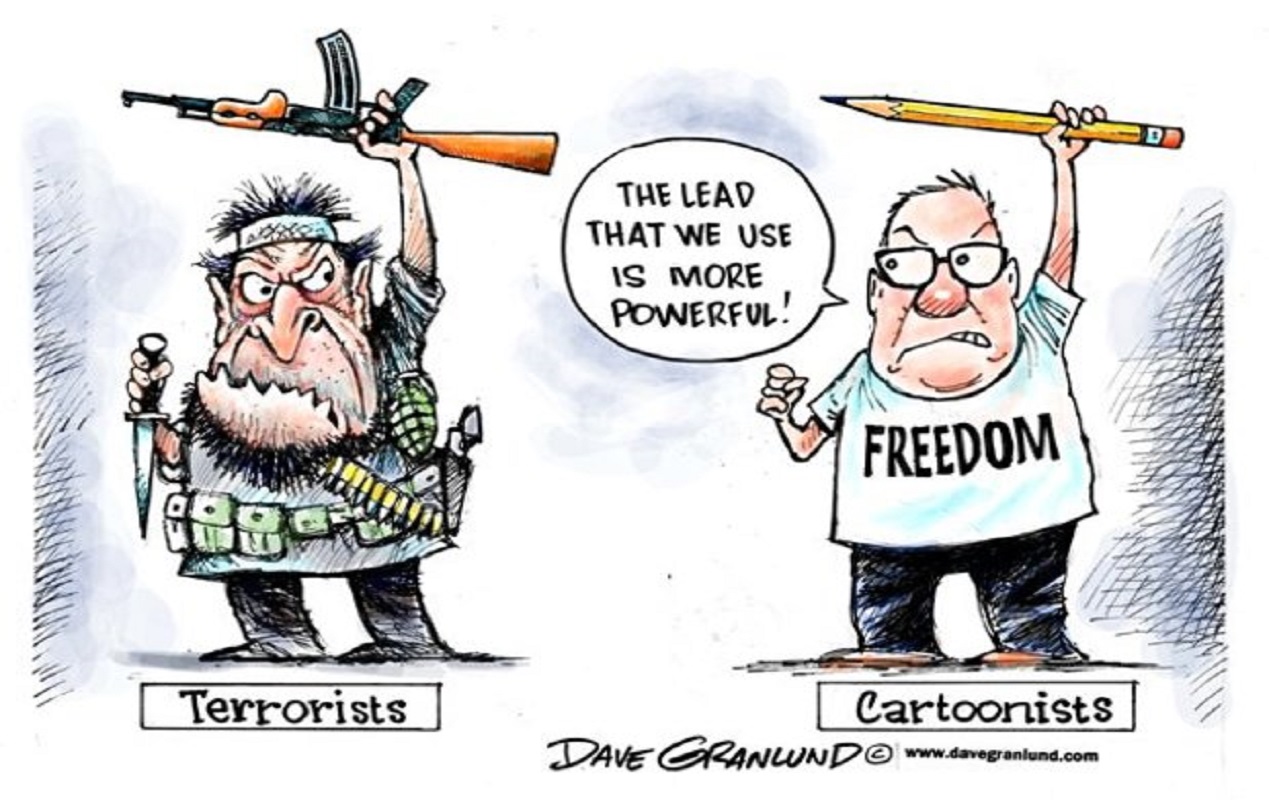

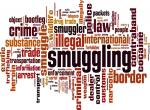
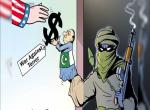



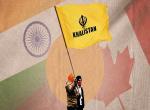


Post new comment